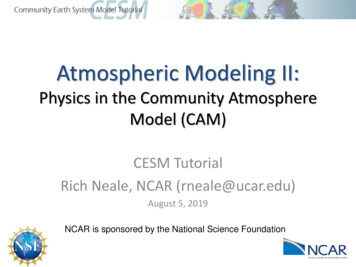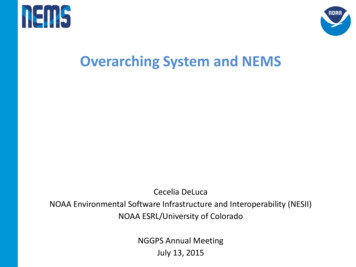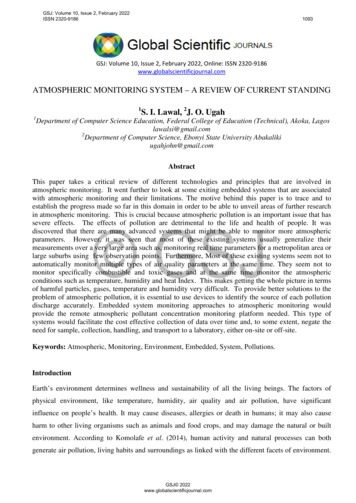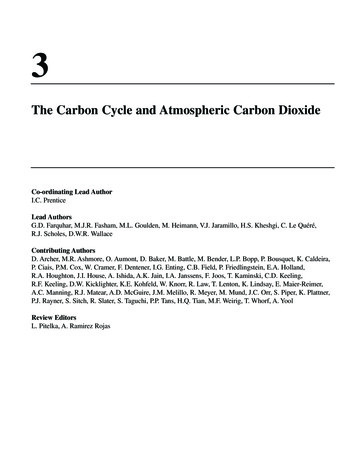
Transcription
Atmospheric Modeling II:Physics in the Community AtmosphereModel (CAM)CESM TutorialRich Neale, NCAR (rneale@ucar.edu)August 5, 2019NCAR is sponsored by the National Science Foundation
Outline Physical processes in an atmosphere GCMDistinguishing GCMs from other models (scales)Concept of ‘Parameterization’ of sub-grid processesPhysics representations (CESM)––––Clouds (different types) and microphysicsRadiationBoundary layers, surface fluxes and gravity wavesUnified turbulence methodology (CESM2) Process interactions Model complexity, sensitivity and climate feedbacks
Scales of Atmospheric ProcessesDetermines the formulation of the model1 weekResolved ScalesClimate ModelsForecast modelsFuture Climate ModelsCloud/Mesoscale/Turbulence ModelsCloud DropsMicrophysics1 sec1m10000 km
Equations of MotionWhere do we put the physics (with the dynamics)?Horizontal scales vertical scalesVertical acceleration gravityFVFTFQV, FQL, FQI transport
Raw topographyat 3km resolution
Resolved topographyfor CAM FV at0.9x1.25 (100 km)resolution
Boundary Layer CloudsAlejandro Selkirk Island (33S 80W)
Deep ConvectionMissouriKansasJuly 15, 2015
What is a ‘Parameterization’? Represent impact of sub-grid scaleunresolved processes on resolved scale Usually based on– Basic physics (conservation laws ofthermodynamics)– Empirical formulations from observations In many cases: no explicit formulationbased on first principles is possible atthe level of detail desired. Why?Vertical eddy transport of χ– Non-linearities & interactions at ‘sub-grid’scale– Often coupled with observationaluncertainty– Insufficient information in the fusivity’Resolved‘grid-scale’
Clouds100km100km
CloudsMultiple Categories Stratiform (large-scale) clouds Shallow convection clouds Deep convection clouds
Stratiform Clouds (macrophysics)Sub-Grid Humidity and Clouds (different from high res) Liquid clouds form when relative humidity 100% (q qsat) But if there is variation in RH in space, some clouds will formbefore mean RH 100% RHcrit determines cloud fraction 0Assumed CumulativeDistribution function ofHumidity in a grid boxwith sub-grid variationCloudFraction 1.0Clear(RH Rhcrit)Cloudy(RH 100%)0.RHcritMean Relative Humidity100%
Shallow and Deep ConvectionExploiting conservation propertiesCommon propertiesParameterize consequences of vertical displacements of air parcelsUnsaturated: Parcels follow a dry adiabat (conserve dry static energy)Saturated: Parcels follow a moist adiabat (conserve moist static energy)Shallow (10s-100s m) - localParcels remain stable (buoyancy 0)Shallow cooling mainlySome latent heating and precipitationGenerally a source of water vaporSmall cloud radius large entrainmentDeep (100s m-10s km) – non-localParcels become unstable (buoyancy 0)Deep heatingLatent heating and precipitationGenerally a sink of water vaporLarge cloud radius small entrainment
Shallow and Deep ConvectionClosure: How much and when?ShallowDeepConvective inhibition (CIN) and turbulentkinetic energy (TKE) CAM5Convective Available Potential Energy(CAPE) CAM4/CAM5/CAM6CAPE CAPEtriggerTimescale 1 hourShallow and deep convection and stratiform cloud fractions combined for radiation
Cloud Microphysics Condensed phase water processes (mm scale)– Properties of condensed species ( liquid, ice) size distributions, shapes– Distribution/transformation of condensed species Precipitation, phase conversion, sedimentation Important for other processes:– Aerosol scavenging– Radiation In CAM ‘stratiform’ cloud microphysics– Convective microphysics very simplified– Formulations currently being implemented into convection
CAM MicrophysicsModalAerosols(MAM4)ModalAerosols(MAM4) Radiation Radiation
RadiationThe Earth’s Energy BudgetTrenberth & Fasullo, 2008GasSWAbsorption(Wm-2)CO21O22O314H2O43 Condensedspecies: Clouds &AerosolsBill Collins, Berkeley & LBLNot Important for weeks forecast!
(TOA)1000nm 1mmInput at TOA, Radiation at surfaceFrom: ‘Sunlight’, Wikipedia
IR absorption“Greenhouse Gases”“Absorption Windows”1000nm 1mm
Planetary Boundary Layer (PBL)Regime dependent representations Vital for near-surface environment(humidity, temperature, chemistry) Exploit thermodynamic conservation(liquid virtual potential temperature θvl) Conserved for rapidly well mixed PBL Critical determinant is the presence ofturbulence Richardson number 1, flow becomes turbulent CAM5: TKE-based Moist turbulence(Park and Bretherton, 2009)
Gravity Waves and Mountain StressesSub-grid scale dynamical forcing Gravity Wave Drag– Determines flow effect of upwardpropagating (sub-grid scale) gravity wavesthat break and dump momentum– Generated by surface orography (mountains)and deep convection Turbulent mountain stress– Local near-surface stress on flow– Roughness length scales grid-scale– Impacts mid/high-latitude flow (CAM5) More difficult to parameterize thanthermodynamic impacts (conservation?)
Community Atmosphere ModelRepresenting the key atmospheric processes in CAM5ParkSWCFZMCloudMacrophysicsand MicrophysicsDynamicsDeep ConvectionAerosolsMGDSDRHShallow ConvectionUWTKE CINRadiationSW LWACAPEM1M2M3 LWCFAbs/Emis/RefUWWindSurfaceFluxesP- GravityWaveDragWindPlanetary Boundary LayerEmissionAlbedo σT4S DepositionSpectral ElementMO stabilitytyFUV, FLH, FSHTurbulent Mountain Stress
Community Atmosphere ModelRepresenting the key atmospheric processes in CAM6CLUBBSWCFZMMG2MicrophysicsDynamicsDeep ectral ElementRadiationSW LWAbs/Emis/Ref - GravityWaveDragLWCFWindWindSCuEmissionAlbedo σT4S DepositionPPBLSurfaceFluxesTurbulent Mountain StressMOstabilitytyFUV FLH, FSH
ZhangMcFarlane(ZM)PBLooooUnifies moist and dry turbulence (except deep convection – CAM6)’Seamless’ representation; no specific case adjustmentsUnifies microphysics (across cloud types)High order closures (1 third order, 6 second order, 3 first order-means)
––––Predict joint PDFs of vertical velocity, temperature and moistureAssume double Gaussians can reflect a number of cloudy regimesPredict grid box means and higher-order momentsTransport, generate, and dissipate mean moments (w’2,w L w’qL’)CloudyStrato-Cu?Shallow-Cu?Clear
Climate SensitivityWhat happens to clouds when we double CO2?GFDL Model 4.2KNCAR Model 1.8KChange in low cloud amount (%) Significant range in low-cloud sensitivity (low and high end of models) Cloud regimens are largely oceanic stratocumulus (difficult to model) Implied temperatures change is due to (higher/lower) solar radiationreaching the ground because of clouds feedbacks.
Model physics: The futureNew and more complex processesCloud super-parameterizationSP-CAM ( )ML-CAM ( )CAM ( )Trained on (SP-CAM)Regional grid and scale-aware physicsMachine Learning (ML)Rasp et al., (2018)https://doi.org/10.1073/pnas.1810286115
Summary GCMs physics unresolved processes parameterization Parameterization (CESM) approximating reality– Starts from and maintains physical constraints– Tries to represent effects of smaller ‘sub-grid’ scales Fundamental constraints, mass & energy conservation Clouds are fiendishly hard: lots of scales, lots of phasechanges, lots of variability Clouds are coupled to radiation (also hard) biggestuncertainties (in future climate); largest dependencies CESM physics increasingly complex and comprehensive Future parameterizations aim to be process scale-awareand model grid-scale independent
Questions?
Atmospheric Modeling II: Physics in the Community Atmosphere Model (CAM) CESM Tutorial Rich Neale, NCAR (rneale@ucar.edu) August 5, 2019 NCAR is sponsored by the National Science Foundation. . sat) But if there is variation in RH in space, some clouds will form before mean RH 100%










